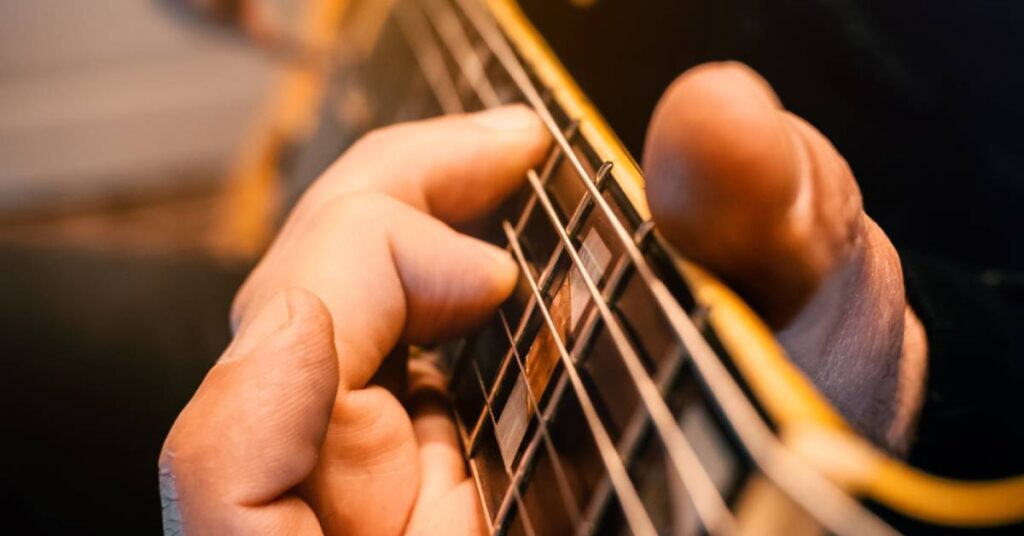
While acoustic guitars have the same general appearance, a lot of differences make each one unique, whether cosmetically or mechanically, or choice of woods.
The variation that can exist from one guitar to another can be huge, and you can personalize your instrument to fit your play style, tone, and aesthetic. You can customize just about every aspect of your guitar, whether it’s something simple, like swapping out the strings, or something more involved, like installing a new set of tuners.
Before you dive into Frankensteining your instrument, it’s best to have an idea of the most popular mods and upgrades for your guitar. Know what will make a difference and how they’ll affect your instrument.
Experiment With Different Strings
One of the easier mods to play with is changing your guitar strings, whether you make them thicker, slimmer, or made of a different material. If you switch to a lighter gauge, you’ll find it easier to bend the strings while you’re playing. Alternatively, getting thicker gauges will make them stiffer but will produce a naturally lower tone and increase volume.
Gauge isn’t the only thing to look at; you can switch up the material if you want! The most common strings on acoustic guitars are phosphor bronze, bronze, and nickel. But there are many options such as stainless steel, titanium, and more.
If you want to try something new, look into Silk & Steel strings for a different feel and sound. Not only are Silk and Steel strings easier on the fingers, but they also provide a whole different range of sound. A lot of classical string instruments use nylon strings, which is a close cousin of silk & steel, therefore giving you a more “classical” guitar sound and tone.
Before looking into new strings, be aware that you may need to modify your guitar’s nut, especially if you install strings with different gauges. The nut may not have the slots filed wide enough to hold the strings, so you may have to switch that out along with your strings or have us reslot your nut slots to the appropriate width/depth.

Replacing the Nut
Speaking of the nut, you can do a number of things to it also to customize your guitar’s sound. Fundamentally, the nut creates enough space between the strings themselves and ensures they sit high enough above the fretboard. However, it can be more than just a piece to keep the strings in place.
Nuts come in a variety of materials. Some of the most popular include the following:
- Plastic is standard for beginner guitars and offers an affordable material at the cost of some nuance to your sound.
- Bone is great for warmer tones and provides a balanced sound.
- Man Made synthetics such as NuBone or Tusq provide their own great tones with adding lubrication in the nut slots for your strings to move while bending and tuning.
- Metal/Brass provides a sharp tone and usually works best with electric guitars.
- Ebony is visually beautiful and gives a soft tone similar to bone.
Look Into New Tuners
The tuners on your guitar obviously keep it in tune, so make sure they work! While standard tuners get the job done, they may wear out relatively quickly.
Higher gear ratio tuners can help you stay in tune better and tune to pitch more accurately vs lower ration tuners. Consider 18:1 vs 16:1, etc. Also elegance can play a factor. Some tuners are outfitted with elaborate engravings and plated with gold or other beautiful finishes.

New Bridge Saddle
The bridge is arguably the biggest “sound affecting” tone in the equation. Going with different materials will greatly affect your overall tone. Same as with nut materials, bone, Tusq, plastic, etc will all give you different sonic elements that will change your tone and voice of your acoustic guitar.
Also getting a “compensated” nut installed will help your guitar play more in-tune as you climb higher on the fretboard. This can be as easy as buying a pre-compensated bone or plastic nut or having your luthier hand carve one out the material of your choice.
Also watch the height of your saddle. To high a saddle will cause high action and intonation problems as well as put undue pressure on your saddle leading to possibly splitting or cracking. To low a saddle height will lend to loss of volume, pickup response issues and possible fret buzz. There is a method to the madness, so ask you luthier for assistance if you are unsure of your situation.
Bridge Pins
Bridge pins also lend to a big part of that tone puzzle we are all putting together. The differences of tins are limitless. From material to elegance there are literally hundreds of different choices to choose from. Some are made of pure bone, some are made from hard metals, some have very elaborate inlays for that very ornate look.
When you do decide to upgrade and change pins, you need to make sure those pins fit correctly. Not only to they serve as a asthetic option, but they do serve a very important purpose. (I’ll save that for another blog) Your pins need to seat just right to assure you have the best possible tone transfer possible. Not too High…not to low. Again, ask your luthier for advice if unsure.
Cosmetic Changes
While cosmetic upgrades may not affect how your guitar sounds, they can go a long way to make your guitar truly yours and not just another instrument off the rack. Here are some popular cosmetic mods for your acoustic guitar:
- Bridge Pins
- Nut
- Tuners
- Straps
- Inlays for the fretboard
- Pickguards
It may also be necessary to switch out some parts of your guitar due to wear and tear or discoloration. Sometimes, that weathered look can also add character to your beloved instrument!
Make Your Guitar Your Own
Whatever you decide to do with your guitar to replace your tuners or look into new strings, every little change makes it more personalized to your style and WILL change the tone of your guitar. Experiment with your sound, listen to what works or what doesn’t, and play around until you find mods that allow you to make the music you want! Most all of these mods are easily reversible, so don’t get nervous.
If you’re in the market for acoustic guitars for sale or want new accessories, we have a wide selection at Backwoods Guitar.
